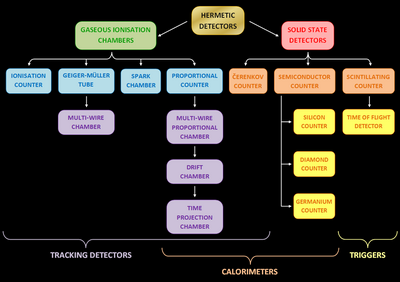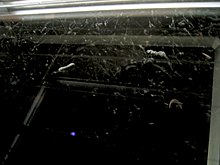Particle detector

A particle detector, also known as a radiation detector, is a device used to detect, track, and/or identify high-energy particles. These particles can be made by nuclear decay, cosmic radiation, or reactions in a particle accelerator. Particle detectors are used in particle physics, nuclear physics, and nuclear engineering. Modern detectors are also used as calorimeters to measure the energy of radiation. They can measure other things, such as the momentum, spin, or charge of the particles.
Description[change | change source]
Detectors designed for modern accelerators are very big. They are also very expensive. They are called counters when they simply count particles, but do not measure anything else. Usually, particle detectors can also track ionizing radiation (high energy photons or even visible light).
Examples and types[change | change source]
Many of the detectors invented so far are ionization detectors (such as gaseous ionization detectors and semiconductor detectors) and scintillation detectors. Other principles, such as Čerenkov light and transition radiation, have also been applied to detect particles.
Applications[change | change source]
Some detectors are used to measure the amount of radiation so that people can protect themselves from it. Others are used to study nuclear and particle physics.
Detectors have also been used in archaeology. Muon detectors can "see" through solid material such as stone and concrete. Used this way, archaeologists and physicists discovered a room (a burial chamber) behind a wall underground in Naples, Italy. [1]


Related pages[change | change source]
References[change | change source]
- Jones, R. Clark (1949). "A New Classification System for Radiation Detectors". Journal of the Optical Society of America. 39 (5): 327–341. Bibcode:1949JOSA...39..327J. doi:10.1364/JOSA.39.000327. PMID 18131432.
- Jones, R. Clark (1949). "Erratum: The Ultimate Sensitivity of Radiation Detectors". Journal of the Optical Society of America. 39 (5): 343. doi:10.1364/JOSA.39.000343.
- Jones, R. Clark (1949). "Factors of Merit for Radiation Detectors". Journal of the Optical Society of America. 39 (5): 344–356. Bibcode:1949JOSA...39..344J. doi:10.1364/JOSA.39.000344. PMID 18144695.
Further reading[change | change source]
- Movie instruction media
- "Radiation detectors". H. M. Stone Productions, Schloat. Tarrytown, N.Y., Prentice-Hall Media, 1972.
- General Information
- Grupen, C. (June 28 – July 10, 1999). "Physics of Particle Detection". AIP Conference Proceedings, Instrumentation in Elementary Particle Physics, VIII. Vol. 536. Istanbul: Dordrecht, D. Reidel Publishing Co. pp. 3–34. doi:10.1063/1.1361756.
